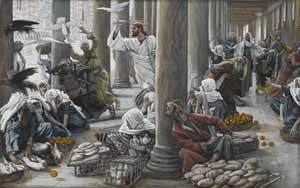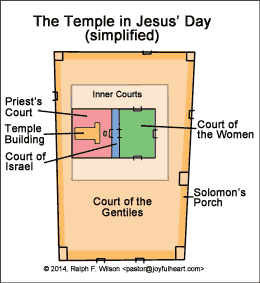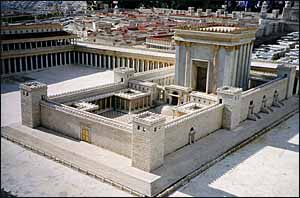
|
Old Testament
New Testament
Gospels
Acts
Paul's Letters
General Letters
Revelation
Topical Studies
Beginning the Journey (for new Christians). en Español

|
Old Testament
New Testament
Gospels
Acts
Paul's Letters
General Letters
Revelation
Topical Studies

|
Home
Bible Studies
Articles
Books
Podcasts
Search
Menu
Donate
About Us
Contact Us
FAQ
Sitemap
5. Cleansing the Temple (John 2:13-25)
by Dr. Ralph F. Wilsonhttps://www.jesuswalk.com/john/05_cleansing.htm
Audio (20:37)
 James J. Tissot, 'The Merchants Chased from the Temple' (1886-94), gouache on paper, 7.25x11.6, Brooklyn Museum.
|
While the turning of water into wine was the first sign of Jesus' ministry, according to John, the first public act of his ministry is to cleanse the temple.
Jesus had been to the temple many times as a boy and as a young man, but now he comes as Messiah. And what has bothered him on his previous visits, he is determined to change.
The Temple in Jerusalem
The first temple was built by Solomon on Mount Moriah in Jerusalem about 950 BC to replace the tabernacle that had been Israel's portable place of worship, first in the wilderness at Sinai and for the next several hundred years at Shiloh. Solomon's Temple was destroyed in 587 BC when Nebuchadnezzar's army destroyed Jerusalem. The next temple was built when the Jews returned from exile under Zerubbabel in about 515 BC. It was damaged, plundered, and desecrated by Greek conqueror Antiochus Epiphanes in 167 BC and later by Roman generals Pompey in 63 BC and Crassus in 54 BC. Herod the Great destroyed some of the temple walls as he stormed Jerusalem in 37 BC.
Herod the Great, now King of the Jews under the Romans, began to rebuild the temple in 20-19 BC, a process that continued for most of the next decade, with further ornamentation continuing perhaps through the 60s AD (cf. 2:20). Since Herod's Temple was constructed over the foundation of the temple built under Zerubbabel in 515 BC (though greatly expanded), it is known by Jews today as the Second Temple. Remnants of this temple are still visible today in the Wailing Wall at the base of its Western Wall.
The temple grounds consisted of several courts surrounding the central temple structure itself.
Court of the Gentiles was the outermost court, paved with stone and surrounded on three sides by porticos, each about 45 feet wide supported by two rows of marble columns some 37 feet high. Jesus and his disciples -- and later the early church -- met under Solomon's Porch on the east side of the temple complex (10:23; Acts 3:11; 5:12). Gentiles as well as Jews were allowed to be there. This was the location where sacrificial animals were sold and money exchanged.
 The Temple in Jesus' Day (Larger diagram) |
Court of Women was divided from the Court of the Gentiles by a stone balustrade, perhaps 4.5 feet high, where women, but not Gentiles, could come and pray.
Courts of Israel and of the Priests were accessible from the Nicanor Gate on the west side of the Court of Women. Within the Court of the Priests were the altar, laver, various chambers, and the Temple building itself.
Temple Building. The front of the temple building was 150 feet wide and high, a gilded spectacle that was the wonder of all. The Second Temple as finally destroyed by the Romans under Titus in 70 AD, and has not been rebuilt. Later the Romans built palaces and a Temple of Jupiter, and the Byzantines a church, on the site. The present Dome of the Rock was built on the site by Muslim conquerors between 687-691 AD and the last remnants of the Second Temple were removed.[72]
Passover and other Jewish Festivals (2:13)
According to the Mosaic Law, all Jews were to come to Jerusalem for three festivals each year:
"Three times a year all your men must appear before the LORD your God at the place he will choose: at the Feast of Unleavened Bread, the Feast of Weeks and the Feast of Tabernacles." (Deuteronomy 16:16; Exodus 23:14-17)
John's Gospel includes mentions of at least three Passovers (2:13, 23; 6:4; and 11:55, etc.). He also mentions Jesus' attendance at the Feast of Tabernacles (7:2-14), the Feast of Dedication (Hanukkah, 10:22), and another feast which isn't specified (5:1).
The incident of Jesus' cleansing of the temple took place at Passover.
"When it was almost time for the Jewish Passover, Jesus went up[73]to Jerusalem." (2:13)
Passover is a celebration of God delivering the Jewish people from Egypt. In remembrance of the Passover lambs sacrificed on the first Passover (Exodus 13), lambs were sacrificed in Jerusalem each Passover.
Desecration of the Temple Courts (2:14)
This wasn't Jesus' first Passover in Jerusalem, by any means. He had doubtless been many times from childhood on (Luke 2:41-50). But this is the first time he has come to Passover during his public ministry. Now is the time for him to begin to call people to repentance in the very center of Judaism:
"In the temple courts he found men selling cattle, sheep and doves, and others sitting at tables exchanging money." (2:14)
Jews came to the Temple from all over Israel, indeed from all over the known world. Most of the time, they couldn't bring animals with them to sacrifice.
Moreover, Passover was the time that people paid the annual temple tax (Matthew 17:24-27; Exodus 30:13, 26). In Jesus' day, many kinds of coinage were circulating. The Romans, of course, had their own coins, but so did many kings and city-states across the empire. The various Herodian kings issued coins, as did the Phoenicians, Aegeans, Corinthians, and Persians. If these were voluntary offerings, perhaps, coins from these various countries and kingdoms might have been accepted. But this was a tax, not an offering. So, probably because of its exact weight and good alloy, Tyrian coinage (from Tyre) is specified in the Mishnah as the only coinage acceptable for the temple tax.[74]Of course, there was a fee to exchange one's coins for the Tyrian coins. The chief priest controlled the entire enterprise of money-changing and sale of sacrificial animals -- and got his percentage of the gross.
The sacrificial animals and money-changing tables were located in the Court of the Gentiles within the temple grounds. So the place designated for believing Gentiles to pray and worship was cluttered with the clink of coins, the braying of animals, and the sounds of commerce -- hardly a place of peace wherein to seek the Lord.
Driving Out the Animals and Moneychangers (2:15-17)
Jesus was outraged.
"15 So he made a whip out of cords[75], and drove all from the temple area, both sheep and cattle; he scattered the coins of the money changers and overturned their tables. 16 To those who sold doves he said, 'Get these out of here! How dare you turn my Father's house into a market!' 17 His disciples remembered that it is written: 'Zeal for your house will consume me.'" (2:15-17)
Jesus was offended, not that pilgrims needed to purchase sacrificial animals -- cattle, sheep, goats, doves/pigeons, etc. -- but that God's house had become perverted from its main function as a house of prayer, and turned into something resembling a market, at which everyone brought their produce, set up stalls, and crowds came to do their shopping.[76]
The verbs are strong -- drove, scattered, overturned! You shall not make....![77]Jesus is obviously angry. So is anger okay? Yes, some anger is appropriate. There are times when the lack of anger at a great injustice shows a disengagement with reality. It's not anger that is the evil, but what that anger causes us to do that is unrighteous (Ephesians 4:6). So we must control our anger so that our actions are appropriate.
For the Son of God to return his Father's House to its rightful state was entirely appropriate, if not "politically correct."
This is the first instance in John's Gospel where Jesus uses this term, "Father." After this, we see it often in this Gospel.[78]The Jewish leaders were highly offended by this because it seemed too intimate, not formal and distant enough. To them it seemed like heresy -- and it would have been if it weren't true.
"For this reason the Jews[79]tried all the harder to kill him; not only was he breaking the Sabbath, but he was even calling God his own Father, making himself equal with God." (5:18)
Jesus uses the phrase "in my Father's house" of the temple here and on the occasion when he is found in the temple as a boy (Luke 2:49). Later, he uses "in my Father's house" of heavenly dwellings (14:2).[80]Here the phrase is used almost as one's ancestral home might be called "the old home place."
His disciples later compared Jesus' passion for his Father's house to David's words in Psalm 69:
"I endure scorn for your sake,
and shame covers my face.
I am a stranger to my brothers,
an alien to my own mother's sons;
for
zeal for your house consumes me,
and the insults of those who insult you fall on me." (Psalm 69:7-9)
Jesus has so identified with his Father, that he sees the merchandising as an insult to his Father, and thus to him. He takes it personally!
Q1. (John 2:14-17) What was going on in the temple? Why
was Jesus offended by it? What action did Jesus take?
https://www.joyfulheart.com/forums/topic/1406-q1-offense-in-the-temple/
Q2 (John 2:11-17) Apparently, Jesus was angry. Was his
anger justified? Why? Is anger good or bad? What about anger gets us into
trouble?
https://www.joyfulheart.com/forums/topic/1407-q2-jesus-anger/
One Cleansing or Two?
While John's Gospel places the cleansing of the temple at the beginning of Jesus' ministry, the Synoptics place it during the last week of his ministry, the precipitating event that caused the Jewish rulers to arrest him. This raises the question of whether there was one cleansing or two.
While the Synoptic account of the cleansing is quite similar to John's, Jesus' comment and the Scripture quoted are different. Matthew wrote:
"Jesus entered the temple area and drove out all who were buying and selling there. He overturned the tables of the money changers and the benches of those selling doves. 'It is written,' he said to them, '"My house will be called a house of prayer," but you are making it a "den of robbers."'" (Matthew 21:12-13)
In Matthew 21:13 Jesus alludes to two verses from the prophets -- different than what we see in John's Gospel:
"... My house will be called a house of prayer for all nations." (Isaiah 56:7)
"Has this house, which bears my Name, become a den of robbers to you? But I have been watching! declares the LORD." (Jeremiah 7:11)
How should we understand the differences between John and the Synoptics? There are three main possibilities.
1. John's chronology is correct. The Synoptics placed the cleansing at the end because they didn't record the events at the previous feasts and Passovers as did John.
2. Synoptic chronology is correct, though John placed the cleansing first for theological or literary reasons. This is the position of the majority of scholars. After all, Luke seems to put Jesus' visit to Nazareth right after Jesus' wilderness temptation for literary and theological reasons (Luke 4:14-30), compared to later in Matthew and Mark (Matthew 13:54-58; Mark 6:2-5).
3. There were two cleansings, one at the beginning and the other at the end of Jesus' ministry. Jesus' comments at the cleansing and the verses quoted are different in the Synoptics and John. It is not unlikely that animals and moneychangers would return to the temple within a short period of time, requiring Jesus to repeat his earlier action.[81]
I'm not sure which view is correct. It is clear that John is both aware of the Synoptic witness to Jesus -- and is, for the most part, independent of the Synoptics in the way he presents Jesus' life and teaching. However, for the purposes of studying John's Gospel, we do well to seek to understand why he includes this particular incident -- and leaves out many others (20:30-31).
Destroy the Temple, Raise It Again in Three Days (2:18-22)
Now we come to a saying of Jesus that is missing in the Synoptics, but alluded to there. After Jesus cleanses the temple, the Jewish leaders challenge his authority to do so.
"Then the Jews[82]demanded of him, 'What miraculous sign can you show us to prove your authority to do all this?'" (2:18)
Apparently, they are saying: If you were a prophet you might have authority to do what you did. Prove to us by some miracle that you are a prophet of God. Though Jesus was entirely capable of doing so, instead he offers them a cryptic saying as a "sign" of his Messiahship, rather than an immediate miracle.
19 Jesus answered them, 'Destroy
this temple, and I will raise it again in three days.'
20 The Jews replied,
'It has taken forty-six years to build this temple, and you are going to raise
it in three days?' 21 But the
temple he had spoken of was his body. 22 After he was raised from
the dead, his disciples recalled what he had said. Then they believed the
Scripture and the words that Jesus had spoken." (2:18-22)
The Jewish leaders obviously thought he was referring to Herod's temple. After all, his presence in this temple seems to be the context of Jesus' statement. His enemies used a somewhat garbled account of these words against him at his trial.
"Then some stood up and gave this false testimony against him: 'We heard him say, "I will destroy this man-made temple and in three days will build another, not made by man."' Yet even then their testimony did not agree." (Mark 14:57-59; cf. Matthew 26:60-61)
Why would Jesus answer his enemies in this way? I think it's similar to the reason he spoke in parables -- so that the spiritually obtuse, those who wouldn't believe no matter what he said, wouldn't understand, but that his disciples would be able to learn.
The bottom line is that no sign would have convinced his enemies, except perhaps his death and resurrection from the dead -- which is the very sign he offers them! He gives his enemies a similar cryptic sign later in his ministry -- the sign of Jonah.
"Then some of the Pharisees and teachers of the law[83]said to him, 'Teacher, we want to see a miraculous sign from you.' He answered, 'A wicked and adulterous generation asks for a miraculous sign! But none will be given it except the sign of the prophet Jonah. For as Jonah was three days and three nights in the belly of a huge fish, so the Son of Man will be three days and three nights in the heart of the earth.'" (Matthew 12:38-40)
Jesus' disciples didn't understand either of these sayings when they were given, but after the resurrection they remembered them and it increased their faith, since they realized that Jesus had foreseen both his death and resurrection.
Did Not Entrust Himself to Followers (2:23-25)
"23 Now while he was in Jerusalem at the Passover Feast, many people saw the miraculous signs he was doing and believed in his name. 24 But Jesus would not entrust himself to them, for he knew all men. 25 He did not need man's testimony about man, for he knew what was in a man." (2:23-25)
We're not told all of the miracles that Jesus did in Jerusalem that Passover, but they must have been considerable. Seeing the miracles prompted initial faith in many people (the verb is pisteuō, "to believe") -- and that was good, so far as it went. But faith that rests on miracles alone, and doesn't mature to embrace Jesus and follow him, is shallow and fickle. Thus, our text says that Jesus didn't "entrust" (NIV, NRSV) or "commit" (KJV) himself to them. The verb again is pisteuō, this time with the connotation of "to entrust oneself to an entity in complete confidence, believe (in), trust, with implication of total commitment to the one who is trusted."[84]
If Jesus had trusted himself to the people, they would have tried to make him king (see 6:15). All around him people were trying to use him for their own purposes -- and continue to do so to this day!
Jesus didn't need to hear people's testimonies and protestations about how much they believed in him. He knew our weaknesses and shallow faith all too well.
 Entire study is available in paperback, Kindle, and PDF formats. |
What amazes me is that he trusted himself to his twelve disciples. Yes, their faith was growing, but still weak and vacillating. And, ultimately, one of his own disciples betrayed him. Yet, he trusts into our hands his mission on earth, the witness to his person and glory, yes, his very reputation. In spite of our weaknesses, he has placed in us, his people, a great and precious trust. Let us live up to his trust!
Q3. (John 2:23-25) What is the problem with faith that
rests solely on miracles? Is it true faith? What is necessary for it to develop
into true faith? Did Jesus see these problems as a reason not to perform
miracles?
https://www.joyfulheart.com/forums/topic/1408-q3-miracles-and-faith/
Prayer
Father, thank you for an example of Jesus' moral outrage and cleansing of the temple. Help us to stand strong against wrongs. And, Lord, cleanse the temples of our hearts, no matter how much we might be offended and upset, so that our hearts might be holy places that welcome you. In Jesus' name, we pray. Amen.
Key Verses
"In the temple courts he found men selling cattle, sheep and doves, and others sitting at tables exchanging money. So he made a whip out of cords, and drove all from the temple area, both sheep and cattle; he scattered the coins of the money changers and overturned their tables. To those who sold doves he said, 'Get these out of here! How dare you turn my Father's house into a market!'" (John 3:14-16, NIV)
"Jesus answered them, 'Destroy this temple, and I will raise it again in three days.' ... But the temple he had spoken of was his body." (John 2:19, 21, NIV)
"But Jesus would not entrust himself to them, for he knew all men. He did not need man's testimony about man, for he knew what was in a man." (John 2:24-25, NIV)
Endnotes
[72]Accessible sources on the temple include: Stephen Westerholm, "Temple," ISBE 1:759-776. Another source of information is Alfred Edersheim, The Temple: Its Ministry and Services As they Were at the Time of Christ (1874; reprinted by Eerdmans, 1958); B. Chilton, P.W. Comfort, and M.O. Wise, "Temple, Jewish," in Craig A. Evans and Stanley E. Porter (editors), Dictionary of New Testament Background (InterVarsity Press, 2000), pp. 1167-1183; M.O. Wise, "Temple," DJG, pp. 811-817.
[73]Jerusalem is always "up," since it is at a higher elevation than nearly all of the territory of Israel.
[74]Bekhorot 8:7. Some have contended that the reason for the money-changers was to only accept coins without heathen symbols on them. However, the Tyrian coins did bear heathen symbols (Morris, John, p. 194; citing Israel Abrahams, Studies in Pharisaism and the Gospels, I (Cambridge, 1917), pp. 83f).
[75]"Whip" (NIV, NRSV), "scourge" (KJV) is phragellion, "whip, lash" made of ropes (far less lethal than the penal 'flagellum' (BDAG 1064). "Cords" is schoinion, "rope or cord" (originally of rushes, then generally of other material) (BDAG 982).
[76]"Market(place) (NIV, NRSV) is literally a "house of merchandise" (KJV). The noun is emporion (from which we get our "emporium"), "place where business is carried on, market, marketplace" (BDAG 325).
[77]"Drove" is a rather violent word: ekballō, "force to leave, drive out, expel" (BDAG 299, 1). "Scattered" (NIV), "poured out" (NRSV, KJV) is ekcheō, "cause to be emitted in quantity, pour out," of coins, "scatter" (BDAG 312, 1b). "Overturned/overthrew" is anastrephō, "to overturn completely, upset, overturn" (BDAG 72, 1). The NIV's wording, "How dare you" gets the idea, but the wording is literally a command: "Do not make...."
[78]John 1:14, 18; 3:35; 4:21, 23; 5:17-26, 36-37, 43, 45, etc.
[79]For John's use of "the Jews" to refer to Jewish leaders, see Appendix 2. "'The Jews' in John's Gospel."
[80]In the parable of the Rich Man and Lazarus, the rich man pleads to Abraham to go to "my father's house" and warn his five brothers (Luke 16:27).
[81]Arguments for two cleansings are presented in Morris, John, pp. 188-192.
[82]For John's use of "the Jews" to refer to Jewish leaders, see Appendix 2. "'The Jews' in John's Gospel."
[84]Pisteuō, BDAG 817, 2aα.
Copyright © 2026, Ralph F. Wilson. <pastor![]() joyfulheart.com> All rights reserved. A single copy of this article is free. Do not put this on a website. See legal, copyright, and reprint information.
joyfulheart.com> All rights reserved. A single copy of this article is free. Do not put this on a website. See legal, copyright, and reprint information.


